Patriot Viper III Review: 2x4 GB at DDR3-2400 C10-12-12 1.65 V
by Ian Cutress on November 18, 2013 1:00 PM ESTCPU Real World
Real world testing is where users will feel the benefits of spending up to 13x on memory. A synthetic test exacerbates a specific type of loading to get peak results in terms of memory read/write and latency timings, most of which are not indicative of the pseudo random nature of real-world workloads (opening email, applying logic). There are several situations which might fall under the typical scrutiny of a real world loading, such as video conversion/video editing. It is at this point we consider if the CPU caches are too small and the system is relying on frequent memory accesses because the CPU cannot be fed with enough data. It is these circumstances where memory speed is important, and it is all down to how the video converter is programmed rather than just a carte blanche on all video converters benefitting from memory. As we will see in the IGP Compute section of this review, anything that can leverage the IGP cores can be a ripe candidate for increased memory speed.
Our tests in the CPU Real World section come from our motherboard reviews in order to emulate potential scenarios that a user may encounter.
USB 3.0 Copy Test with MaxCPU
We transfer a set size of files from the 120GB OCZ Vertex3 connected via SATA 6 Gbps on the motherboard to the 240 GB OCZ Vertex3 SSD with a SATA 6 Gbps to USB 3.0 converter via USB 3.0 using DiskBench, which monitors the time taken to transfer. The files transferred are a 9.2 GB set of 7539 files across 1011 folders – 95% of these files are small typical website files, and the rest (90% of the size) are precompiled installers. In an update to pre-Z87 testing, we also run MaxCPU to load up one of the threads during the test which improves general performance up to 15% by causing all the internal pathways to run at full speed.
Results are represented as seconds taken to complete the copy test, where lower is better.

WinRAR 4.2
With 64-bit WinRAR, we compress the set of files used in the USB speed tests. WinRAR x64 3.93 attempts to use multithreading when possible, and provides as a good test for when a system has variable threaded load. WinRAR 4.2 does this a lot better! If a system has multiple speeds to invoke at different loading, the switching between those speeds will determine how well the system will do.

WinRAR is another test we usually see the best memory do well on - the Patriot definitely seems to do the business in our test.
FastStone Image Viewer 4.2
FastStone Image Viewer is a free piece of software I have been using for quite a few years now. It allows quick viewing of flat images, as well as resizing, changing color depth, adding simple text or simple filters. It also has a bulk image conversion tool, which we use here. The software currently operates only in single-thread mode, which should change in later versions of the software. For this test, we convert a series of 170 files, of various resolutions, dimensions and types (of a total size of 163MB), all to the .gif format of 640x480 dimensions. Results shown are in seconds, lower is better.
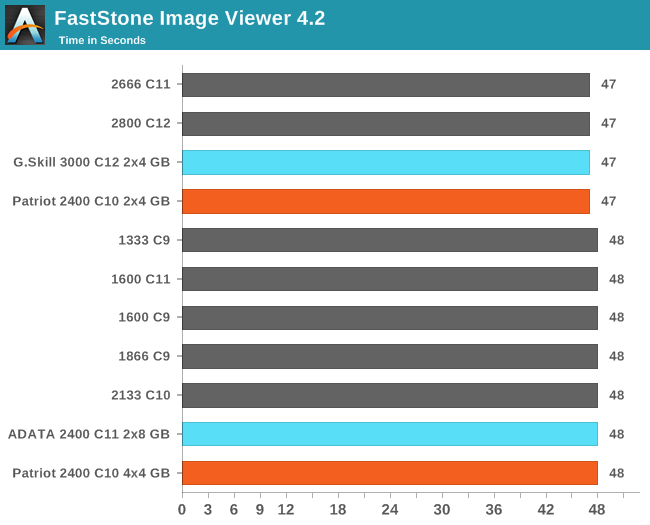
Xilisoft Video Converter 7
With XVC, users can convert any type of normal video to any compatible format for smartphones, tablets and other devices. By default, it uses all available threads on the system, and in the presence of appropriate graphics cards, can utilize CUDA for NVIDIA GPUs as well as AMD WinAPP for AMD GPUs. For this test, we use a set of 33 HD videos, each lasting 30 seconds, and convert them from 1080p to an iPod H.264 video format using just the CPU. The time taken to convert these videos gives us our result in seconds, where lower is better.
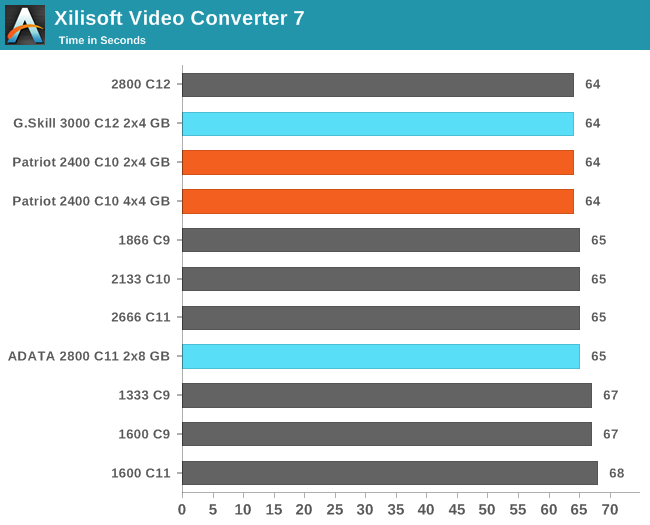
Video Conversion - x264 HD Benchmark
The x264 HD Benchmark uses a common HD encoding tool to process an HD MPEG2 source at 1280x720 at 3963 Kbps. This test represents a standardized result which can be compared across other reviews, and is dependent on both CPU power and memory speed. The benchmark performs a 2-pass encode, and the results shown are the average frame rate of each pass performed four times. Higher is better this time around.
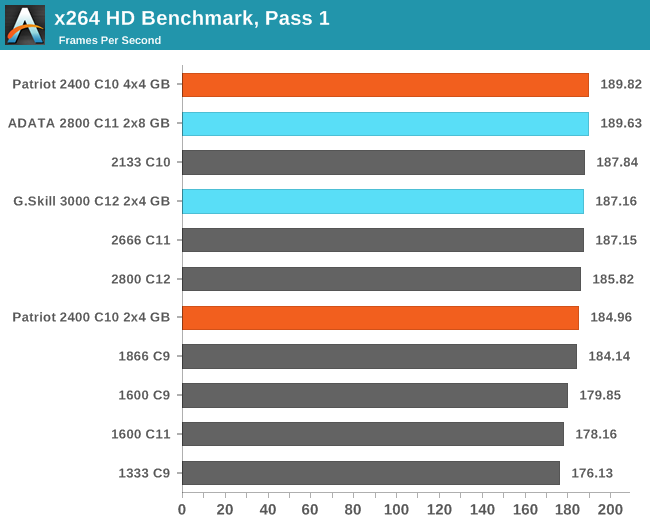
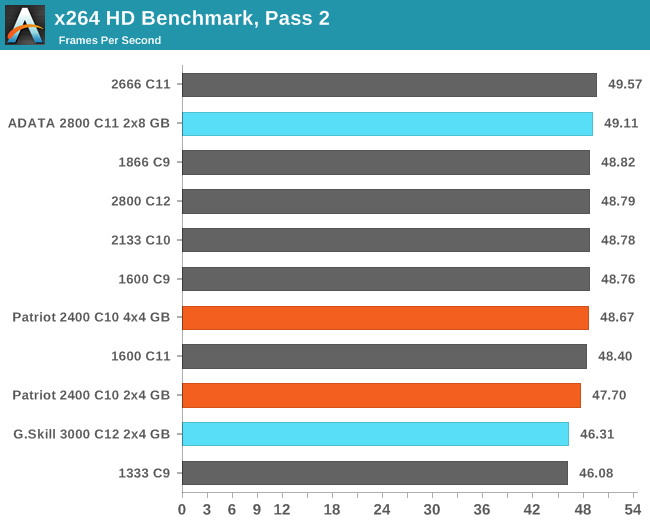
TrueCrypt v7.1a AES
One of Anand’s common CPU benchmarks is TrueCrypt, a tool designed to encrypt data on a hard-drive using a variety of algorithms. We take the program and run the benchmark mode using the fastest AES encryption protocol over a 1GB slice, calculating the speed in GB/s. Higher is better.
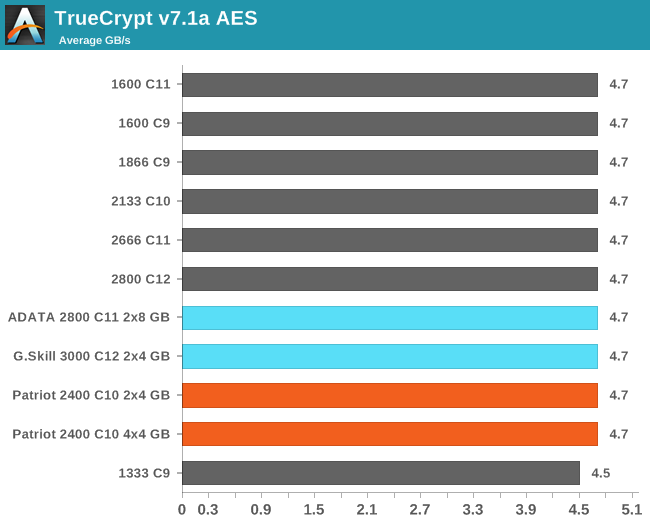










48 Comments
View All Comments
Impulses - Monday, November 18, 2013 - link
Ian has a pretty in depth article on this subject, look back thru the archives.Memory prices haven't increased as much as I thought, if at all... I bought a 1600 4x4GB Patriot kit last year, precisely around this time, it was like $55 or something with a discount (I remember not seeing any better deals around Black Friday). My first exposure to Patriot too but it's worked out well.
hp9000 - Friday, November 22, 2013 - link
I'm not so sure about that, I bought a 32gb 1866 G.Skill Ares kit in December of last year for $109.99 (I'm looking at the invoice) and now the same kit is $283.49 (newegg). That's a huge price increase in my book.IanCutress - Monday, November 18, 2013 - link
You want my memory scaling article on Haswell:http://www.anandtech.com/show/7364/memory-scaling-...
There are 26 different combinations of MHz / CAS there, from 1333 C9 to 3000 C12, representative of many 2x4 GB Hynix MFR kits available to purchase today.
Franzen4Real - Monday, November 18, 2013 - link
Oh great!! Thank You!! Not sure how I missed that in the first place.... Bigtime thanks for all of your time and effort on these tests!!djscrew - Tuesday, November 19, 2013 - link
A (very) basic rule of thumb: 1 Cas Latency = 1 Command Rate = 1 Bump in MHz (1333/1600/1866). With the bump in MHz considered more valuable.dingetje - Monday, November 18, 2013 - link
1.65 volt and higher ?so the haswell memory controller doesnt have a problem with voltage higher than 1.5 or will it get fried eventually ?
IanCutress - Monday, November 18, 2013 - link
Did you used to have Hyper memory on Nehalem by any chance? That combination had issues above 1.75 volts. I have not encountered any issues running memory up to 1.75v on Sandy Bridge, Ivy Bridge or Haswell. All my chips just work. Otherwise 1.65 volt kits wouldn't be selling as well as they do, and overclockers wouldn't be pushing 1.8v on air / 2.0+ volts on liquid nitrogen.dingetje - Tuesday, November 19, 2013 - link
that it runs great i dont doubt....was just wondering wether on the long term the hawell memory controller will have issues (seeing the spec is 1.5)dingetje - Tuesday, November 19, 2013 - link
^haswell (typo)im running a 1.35v (@1.5v) crucial kit myself on haswell by the way
mfenn - Tuesday, November 19, 2013 - link
Yes, because extreme overclockers care so much about longevity. Ian, you should make an effort to get out of the extreme OC and corporate PR echo chambers once and a while. It is really having an effect on the quality of your articles.